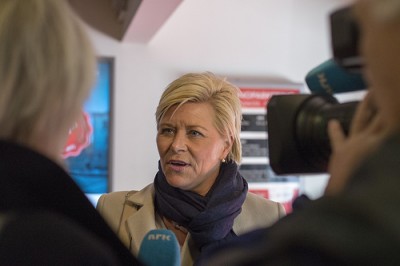Siv Jensen, leader of Norway’s most conservative party in Parliament, faced a busy weekend of rallying her troops for the fall elections as they gathered at Gardermoen Friday for their annual national meeting. The Progress Party (Fremskrittspartiet, Frp) has lost more than half its voters since the last election and needs them back before Election Day on September 9.

To help get them, Jensen delivered a predictably fiery address to fire up the troops on the meeting’s opening day, claiming that the incumbent left-center government that’s hoping for a third term is more concerned about retaining power than in carrying out their politics.
“Jens Stoltenberg will gladly talk about ‘the Norwegian model,'” Jensen claimed. “The Progress Party will rather talk about the Norwegian people.”
She also generated loud applause and cheers from the crowd when she said that “we want Frp’s politics in the government but we don’t want to join the government to ride in fine cars. We want to be in the government because we have a political project to make daily life better for the most folks.”
The party’s members claimed that Jensen “bubbled over” with enthusiasm on stage as she led their 40th national meeting, and that she’s clearly ready for a major campaign battle ahead. “We have ambitions and visions for Norway,” Jensen said. “We will head out and run our election campaign, and we will bring common sense to the people.”

She faces a tough job ahead. The party had record support at the last election in 2009, with 22.9 percent of the vote, well ahead of the Conservative Party (Høyre), with 17.2 percent. For many months afterwards, Jensen’s thriving party usually referred to as “Frp” remained much bigger than Høyre, and the media started writing and talking about how voters would face a choice between “Jens or Jensen” at the 2013 elections.
Over the past year, however, as Frp made clear attempts to ally itself with Høyre and build a clear non-socialist majority in Parliament, the party ended up losing voters, mostly to Høyre. The lines between them because too fuzzy, some political analysts say, and the non-socialist (borgerlige) voters in Norway moved towards the less radical of the two conservative parties.
Recent public opinion polls have shown Frp with just 11.9 percent of the vote, meaning the party risks losing half of its seats in Parliament if the poll result translates into an election result. Suddenly, because of the polls, it’s became not “Jens vs. Jensen” for the prime minister’s post but Jens vs Erna Solberg, the head of the Høyre Conservatives.
That’s disappointed Jensen, who now needs to set Frp’s politics apart from Høyre’s and win back voters on the basis of such longstanding Frp policies as tax cuts, more use of oil revenues, more controls on immigration, more money for roads, less government regulation, less tax burden on car owners and less government bureaucracy. Jensen still wants to be part of a non-socialist government and claims Frp won’t support any government in which it’s not included.
She has conceded that Frp will likely need to make a lot of compromises in order to cooperate with Høyre and, possibly, the other non-socialist parties like the Liberals (Venstre) and the Christian Democrats (Kristelig Folkeparti, KrF). The party’s slogan of seeking to “renew Norway” (external link) can’t be compromised too much, though, with Jensen claiming she’ll insist on acceptance of certain policies in order to bring her still-substantial number of voters to Høyre to form a government.
Jensen, now seen as a likely candidate for finance minister in a prospective non-socialist government, also aims to attract more women to her party in the months ahead as she campaigns for key issues like reducing state support for foreign aid, farmers and cultural activities, selling off state railway NSB and phasing out the state wine and liquor monopoly Vinmonopolet. That may not be easy but the party does put huge emphasis on funding for police, elder care and schools. Those are core services that could appeal to women in a party that’s still dominated by men.
During the weekend, the party’s biggest job will be agreeing on party leadership (with Jensen as leader and possibly the widely respected Kjetil Solvik-Olsen and Anders Anundsen as deputy leaders) and on a party platform heading into the election campaign. One of the key issues in the proposed platform that sets Frp apart from all the other parties, is its desire to invest more of Norway’s oil revenues in roads and infrastructure, instead of on foreign stock exchanges. That is one issue that, in the end, may appeal to the most voters of all.
Views and News from Norway/Nina Berglund
Please support our news service. Readers in Norway can use our donor account. Our international readers can click on our “Donate” button:

